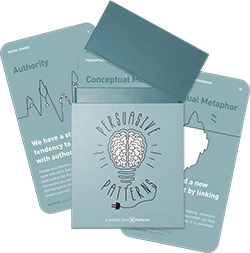Inaction Inertia Effect
Design Pattern
Problem summary
We are less likely to buy having previously missed a more attractive offer
Usage
- Use to make sure that you don’t optimise for short term gains when making promotional offers, but also account for how customers will buy after the promotion is over
- Use to adjust your promotions to make every offer unique
This card is part of the Persuasive Patterns printed card deck
The Persuasive Patterns Card Deck is a collection of 60 design patterns driven by psychology, presented in a manner easily referenced and used as a brainstorming tool.
Get your deck!Solution
You need to consider several factors when putting your product on a discount:
- A discount needs a reason. We tend to be unwilling to grab the same product after we miss a discount as the discount reduces the perceived value of the product and anchors our expectations at a new, lower, baseline. Avoid short-term price wars as you risk setting a new inflexible expectation regarding the too good bargain. Customers need to understand why the product is discounted and why it shortly won’t be.
- Change appearance from offer to offer. Change product characteristics or promotional formats to avoid product price comparison by changing how the product appears or is promoted. Think in season, size, quantity, and other things that can make the offer stand out from how it’s regularly represented.
- Reduce comparability. When two promotions are directly comparable (for instance through price alone), consumers perceive the opportunities more comparable, which results in consumers expressing higher inaction inertia.
Rationale
When missing an appealing offer, a less attractive but still desirable deal is likely to be forfeited. As the difference between the first and second offer grows, so does the prominence of the effect. The effect can be explained by regret, as missing is seen as a loss, and as a devaluation of the later offer, as the first offer seems to serve as an anchor against the current one.
The Inaction Inertia Effect has been examined closely by decision theory within the field of behavioral economics.
1 Zeelenberg, M., Nijstad, B. A., van Putten, M., & van Dijk, E. (2006). Inaction inertia, regret, and valuation: A closer look. Organizational Behavior and Human Decision Processes, 101(1), 89–104
2 van Putten, M et al (2013). Inaction inertia, European Review of Social Psychology, 24(1), 123–159
3 Liu, H.-H. and Chou, H.-Y. (2021), Effects of comparability of promotions on inaction inertia, Marketing Intelligence & Planning, Vol. 39 No. 1, pp. 125-139.
4 Inaction Inertia Effect at Learning Loop
User Interface Design Patterns
- Forms
- Explaining the process
- Community driven
- Tabs
- Jumping in hierarchy
- Menus
- Content
- Gestures
- Tables
- Formatting data
- Images
- Search
- Reputation
- Social interactions
- Shopping
- Increasing frequency
- Guidance
- Registration
Persuasive Design Patterns
- Loss Aversion
- Other cognitive biases
- Scarcity
- Gameplay design
- Fundamentals of rewards
- Gameplay rewards


